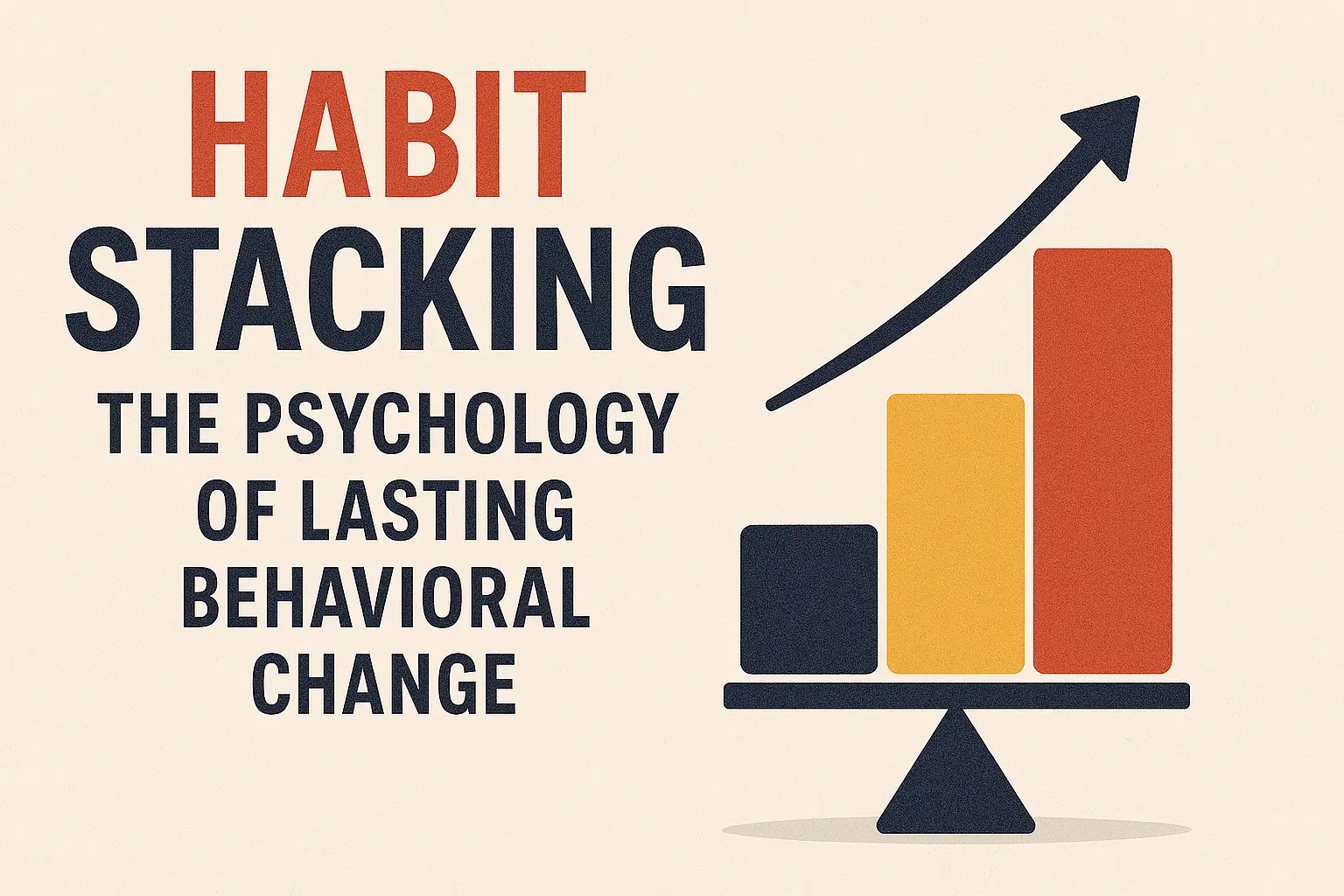Sarah used to struggle with adding meditation to her routine. After months of missed sessions, she tried pairing it with her morning coffee ritual. Within weeks, the practice stuck. This simple strategy—tying new behaviors to established patterns—is how habit stacking rewires the brain for lasting change.
Neuroscience reveals why this method works. Every repeated action strengthens neural pathways, like carving grooves in a record. As James Clear explains in Atomic Habits, your brain prunes unused connections while reinforcing frequent ones. By anchoring fresh goals to daily rituals—say, stretching after brushing your teeth—you tap into existing motivation circuits.
This approach turns small wins into big transformations. Instead of relying on willpower, you create automatic connections between actions. Over time, these linked behaviors build momentum, making progress feel effortless. Whether you’re learning a language or improving fitness, stacking turns aspirations into consistent action.
Key Takeaways
- Existing routines act as anchors for building sustainable new behaviors
- Neuroplasticity allows the brain to strengthen useful neural pathways through repetition
- Linking small actions creates compound growth in personal development
- Strategic cue-based systems reduce reliance on fleeting willpower
- Science-backed methods make behavioral change more predictable and achievable
Understanding the Foundations of Habit Stacking
Imagine transforming your morning coffee ritual into a launchpad for personal growth. This powerful concept lies at the heart of behavioral design strategies that help people create lasting change.
Defining Action Chaining
Behavioral scientists call this method action chaining—connecting fresh goals to established patterns. BJ Fogg’s research at Stanford shows that pairing new behaviors with existing routines increases success rates by 70% compared to standalone efforts. As he states:
“Growth comes from smart anchors, not sheer effort.”

Rhythm of Repetition
Consistent daily patterns act like scaffolding for fresh goals. When you link actions—such as journaling after lunch—you tap into your brain’s natural wiring. Neuroscientists found that repeated sequences strengthen synaptic connections, making behaviors more automatic over time.
Three practical steps to start:
- Identify 2-3 existing daily anchors (like brewing coffee)
- Choose micro-actions requiring under 2 minutes
- Track progress using simple checklists
James Clear’s Atomic Habits principle applies here: “Make it obvious, easy, and satisfying.” By piggybacking on your current rhythm, you build momentum that turns aspirations into everyday reality.
Deep Dive into habit stacking psychology
Your brain’s wiring isn’t fixed in stone—it reshapes itself like clay on a potter’s wheel. Oxford researchers discovered newborns have 50% more neural connections than adults. This pruning process isn’t loss, but refinement. As we age, the brain strengthens pathways we use often and trims the rest.

Neuroplasticity and Synaptic Pruning
Every time you repeat an action—like doing push-ups after brushing teeth—you etch deeper grooves in your neural landscape. This neuroplasticity allows the brain to reorganize itself. Studies show consistent morning exercise routines strengthen motor cortex connections within 21 days.
Synaptic pruning works like a gardener trimming bushes. Frequently used pathways grow thicker myelin sheaths, speeding signal transmission. Unused ones fade—explaining why skipping workouts makes restarting harder. As one Oxford paper states:
“Neural networks thrive on repetition, wither through neglect.”
Building Strong Neural Pathways for Change
Creating lasting connections requires strategic repetition. Pairing a new goal with existing routines—say, hydrating before breakfast—leverages established brain patterns. Seven consecutive days of practice can shift actions from conscious effort to automatic behavior.
Three science-backed principles:
- Anchor fresh goals to strong existing triggers (like morning alarms)
- Keep initial efforts under 90 seconds to bypass resistance
- Celebrate small wins to reinforce dopamine-driven learning cycles
This approach transforms sporadic attempts into ingrained patterns. Whether learning Spanish during commutes or practicing gratitude before bed, the brain’s adaptability makes transformation possible—one reinforced connection at a time.
Identifying Your Daily Routines for Effective Stacking
What patterns already shape your day without conscious effort? The key to lasting change lies in recognizing these automatic rhythms. Start by tracking your existing anchors—the consistent actions that frame your mornings, work hours, and evenings.

Mapping Existing Habits and Triggers
Create a list of recurring moments: brewing coffee, commuting, or washing dishes. These become launchpads for fresh behavior. A 2023 University of Southern California study found people with structured daily routines achieved 43% more personal growth goals than those without systems.
Try this exercise:
- Jot down 5-7 fixed daily actions (e.g., brushing teeth, starting your computer)
- Note their time and physical place
- Highlight triggers with natural pauses—like finishing a lunch break
Behavioral designer Nir Eyal suggests:
“Your best cues hide in plain sight—leverage what already works.”
Pair a newgoalwith an established action. Forexample, add 2 minutes of deep breathing after locking your front door each morning.
This method turns mundane tasks into stepping stones. By understanding your day’s architecture, you’ll discover hidden opportunities for growth between routine moments.
Step-by-Step Guide to Building New Habits
Building lasting change starts with smart triggers, not sheer willpower. By strategically selecting cues that align with your natural rhythms, you create frictionless pathways for growth.
Choosing the Right Cue for Your New Habit
Effective triggers act like launchpads. Look for existing actions you perform without thinking—locking your front door or pouring your first coffee. BJ Fogg’s research emphasizes:
“The best cues are specific and unavoidable—they create natural momentum.”
For instance, closing your laptop lid could trigger a 1-minute breathing exercise. Putting on running shoes might initiate a 5-minute walk. These precise moments bypass decision fatigue.
Pairing New Behaviors with Established Routines
Link fresh actions directly to completed tasks. Try meditating immediately after turning off your morning alarm. Do three push-ups right after tying your work shoes. This creates domino-effect patterns.
Three proven pairing rules:
- Anchor to high-frequency routines (like meal times)
- Keep initial actions under 90 seconds
- Use physical objects as visual reminders
Track progress by marking a calendar each day you complete the sequence. Celebrate completing your goal seven times—research shows this reinforces neural pathways. Small wins build unstoppable momentum.
Practical Habit Stacking Examples in Everyday Life
Transform daily rituals into powerful growth engines with these actionable strategies. By linking simple actions to existing patterns, you create effortless momentum for lasting change.
Morning and Evening Routine Stacks
Start your day strong by pairing your first coffee with a 3-minute meditation. This creates mental clarity before tackling tasks. After dinner, place a book on your pillow—this visual cue encourages reading instead of screen time before bed.
| Routine Trigger | New Action | Benefit |
|---|---|---|
| Turning off morning alarm | Drink 8oz water | Hydration boost |
| Closing laptop at work | 2-minute stretch | Physical reset |
| Brushing teeth at night | Write tomorrow’s priority list | Mental preparation |
Creative Ways to Integrate Habit Stacking
Use your lunch break to practice deep breathing while waiting for food to heat. Keep resistance bands by your desk chair for quick exercises during phone calls. These micro-actions compound into significant lifestyle improvements over time.
Consider these innovative pairings:
- After locking your front door: Text a loved one appreciation
- While coffee brews: Do 5 push-ups or plan your top 3 goals
- Before opening social media: Read one educational article
Research shows habit stacking works best when tied to specific locations or objects. Try different combinations for 7 days—track what sticks. Small adjustments create ripple effects that reshape your entire day.
Incorporating Behavioral Science Principles
What if brushing your teeth could unlock your next big achievement? Behavioral science reveals how strategic rewards turn mundane tasks into powerful motivation engines. By understanding these mechanisms, you can design daily goals that stick through intelligent reinforcement.
The Premack Principle and Reward Systems
Psychologist David Premack discovered a simple truth: high-probability behaviors reinforce low-probability ones. Think of it as the “carrot” approach. For example, watching your favorite show (enjoyable activity) becomes the reward for completing a workout (less appealing task). This principle explains why health-focused routines succeed when paired with natural incentives.
Effective rewards share three traits:
- Immediate: Your brain learns fastest when rewards follow actions within 60 seconds
- Meaningful: Choose incentives that spark genuine satisfaction, like savoring coffee after morning stretches
- Consistent: Repeat the action-reward cycle to strengthen neural associations
“Reinforcement isn’t bribery—it’s the brain’s native language for learning.”
Try this workday application: After sending five emails, take a walk outside. The anticipation of fresh air fuels productivity. At home, pair flossing (often neglected) with a minty mouthwash rinse—the crisp sensation becomes its own reward.
Even micro-rewards matter. Smiling briefly after locking your front door reinforces security habits. Reading one page of a book post-dinner builds literary momentum. These tiny wins create change through compound interest, as noted in science-backed methods for lasting transformation.
Your day becomes a series of intentional dominoes. Each completed action triggers the next, with rewards weaving through your routines like golden threads. By aligning with your brain’s wiring, you transform “should dos” into “want tos”—one reinforced connection at a time.
Overcoming Challenges and Ensuring Consistency
Progress rarely follows a straight path—life’s interruptions test even the best-laid plans. The key to lasting change lies in anticipating obstacles and designing flexible systems. When a missed workout or forgotten meditation session occurs, it’s not failure—it’s data for improvement.
Dealing with Setbacks and Adjusting Your Approach
Unexpected disruptions often derail routines. A work trip might break your morning journaling streak. Instead of abandoning your goal, modify the trigger. Try writing three gratitude notes on your phone during the hotel elevator ride. As James Clear advises:
“Missing once is an accident. Missing twice is the start of a new pattern.”
Three recovery strategies:
- Implement a “two-day rule”—never skip the same action twice
- Simplify actions during high-stress periods (5-minute walks instead of gym sessions)
- Use visual reminders like sticky notes on bathroom mirrors
Tracking Progress and Celebrating Small Wins
Consistency thrives on visible momentum. A 2024 study showed people using habit trackers achieved 68% more goals than those relying on memory. Try this approach:
| Tool | Method | Frequency |
|---|---|---|
| Checklist app | Mark completed actions | Every time |
| Journal | Record weekly reflections | Sundays |
| Calendar | Color-code success days | Daily |
Celebrate micro-wins—like completing seven consecutive days of hydration—with non-food rewards. A new book or longer lunch break reinforces positive associations. These moments activate dopamine release, wiring your brain to crave repetition.
When motivation dips, revisit your “why.” Connect each small action to larger aspirations. Remember: lasting transformation grows from daily seeds, not occasional leaps.
Conclusion
Every sunrise offers a blank slate for reshaping your daily patterns. By linking fresh goals to existing actions—like reviewing priorities while your coffee brews—you leverage your brain’s natural wiring for automatic progress. This method, rooted in James Clear’s Atomic Habits philosophy, turns small, consistent efforts into life-altering results over time.
Revisiting the step-by-step guide helps maintain momentum. Start with clear triggers—your morning alarm or evening teeth-brushing ritual—then pair them with micro-actions that take under two minutes. Celebrate completing seven consecutive days to strengthen those neural connections.
True transformation happens when intentional choices become second nature. Whether improving health through post-lunch walks or advancing career goals with focused work sessions, your routines hold untapped potential. Today’s anchored actions create tomorrow’s unstoppable momentum—one intentional day at a time.
FAQ
What makes habit stacking more effective than standalone behavior changes?
This method leverages existing neural pathways by attaching fresh actions to established routines. The brain’s preference for pattern recognition reduces cognitive load, making consistency easier to maintain compared to isolated efforts.
How does neuroplasticity influence long-term behavioral shifts?
Repeated actions strengthen synaptic connections through myelin sheath development, physically rewiring the brain. This biological process explains why daily dental flossing after brushing becomes automatic over time.
Can I stack multiple behaviors to one existing routine?
Yes, but cognitive science suggests starting with single pairings. Once a morning coffee + gratitude journal combination sticks, add a third element like stretching. Progressive layering prevents overwhelm.
What’s the optimal time window for anchoring new actions?
Research indicates 90-second integration periods work best. Pairing a two-minute meditation practice immediately after brewing afternoon tea creates a tight neurological association without disrupting workflow.
How do reward systems enhance habit formation success rates?
Dopamine release from immediate gratification – like savoring dark chocolate after completing a workout stack – reinforces behavior loops. The Premack Principle shows high-probability rewards boost low-probability actions.
What if my work schedule disrupts established routines?
Identify mobile anchors like commute times or lunch breaks. Listening to educational podcasts during subway rides or doing desk stretches after Zoom calls maintains consistency despite shifting calendars.
How long until stacked behaviors become automatic?
While the 66-day average is often cited, complexity matters. Simple stacks (water consumption after bathroom visits) may stick in 3 weeks, while elaborate morning routines could require 4 months of deliberate practice.




























































